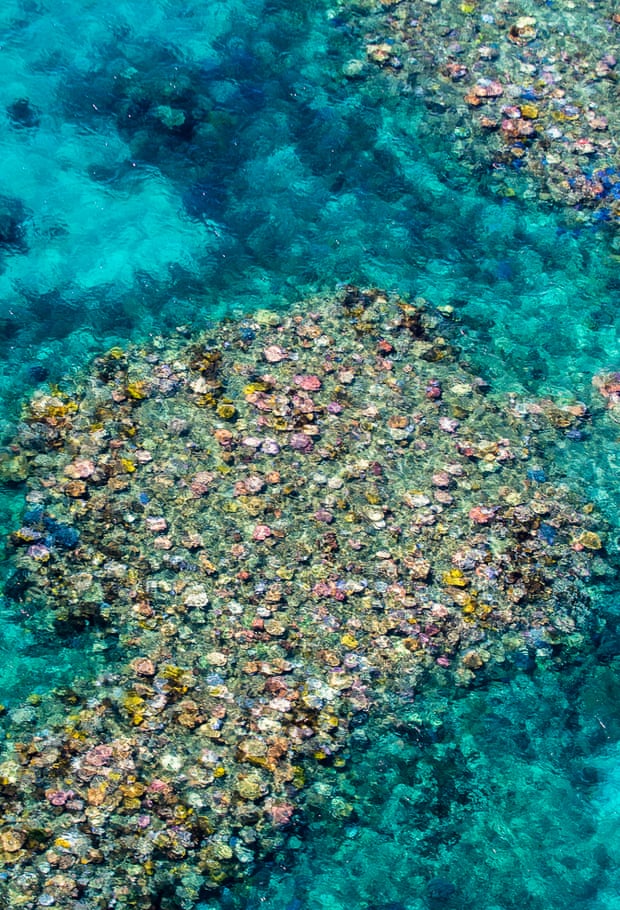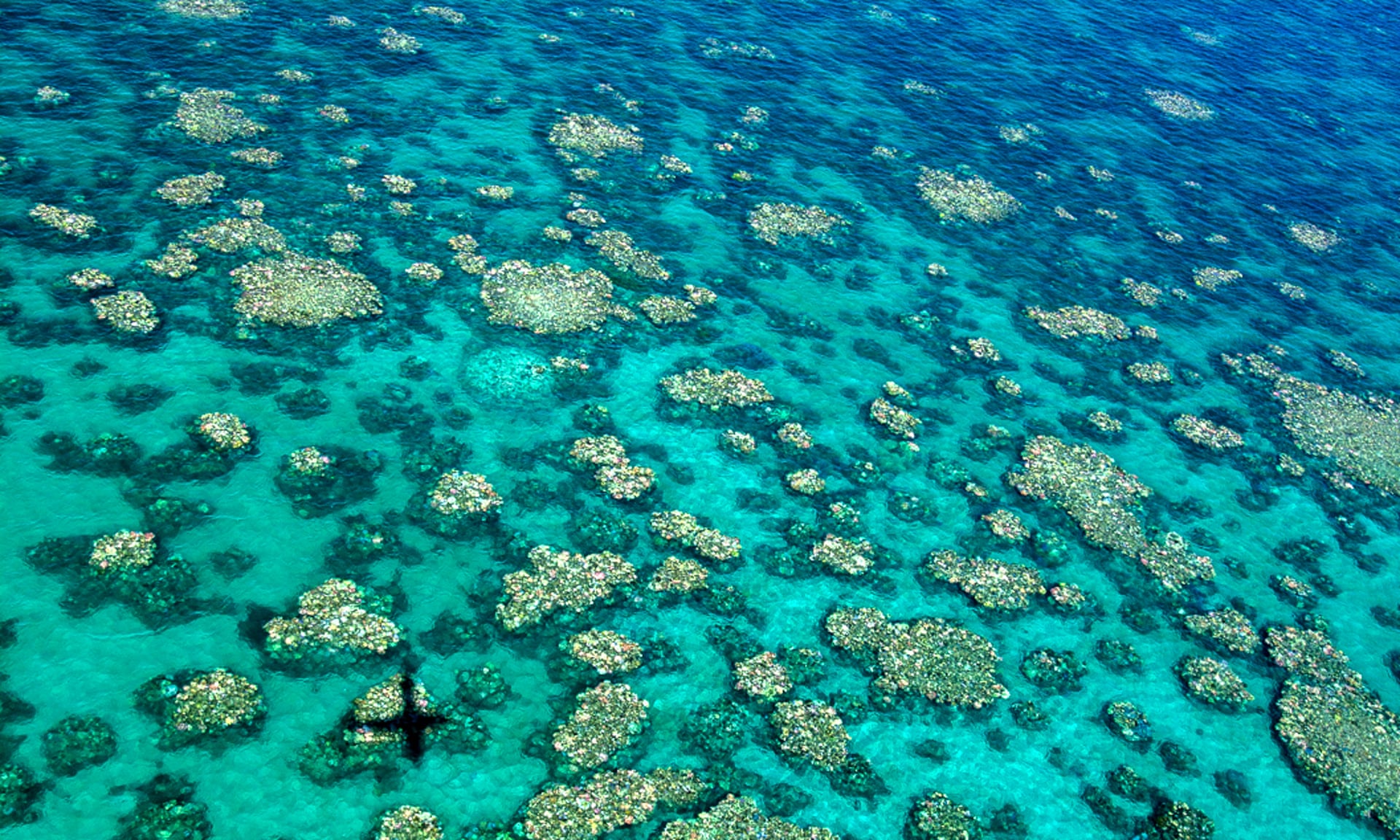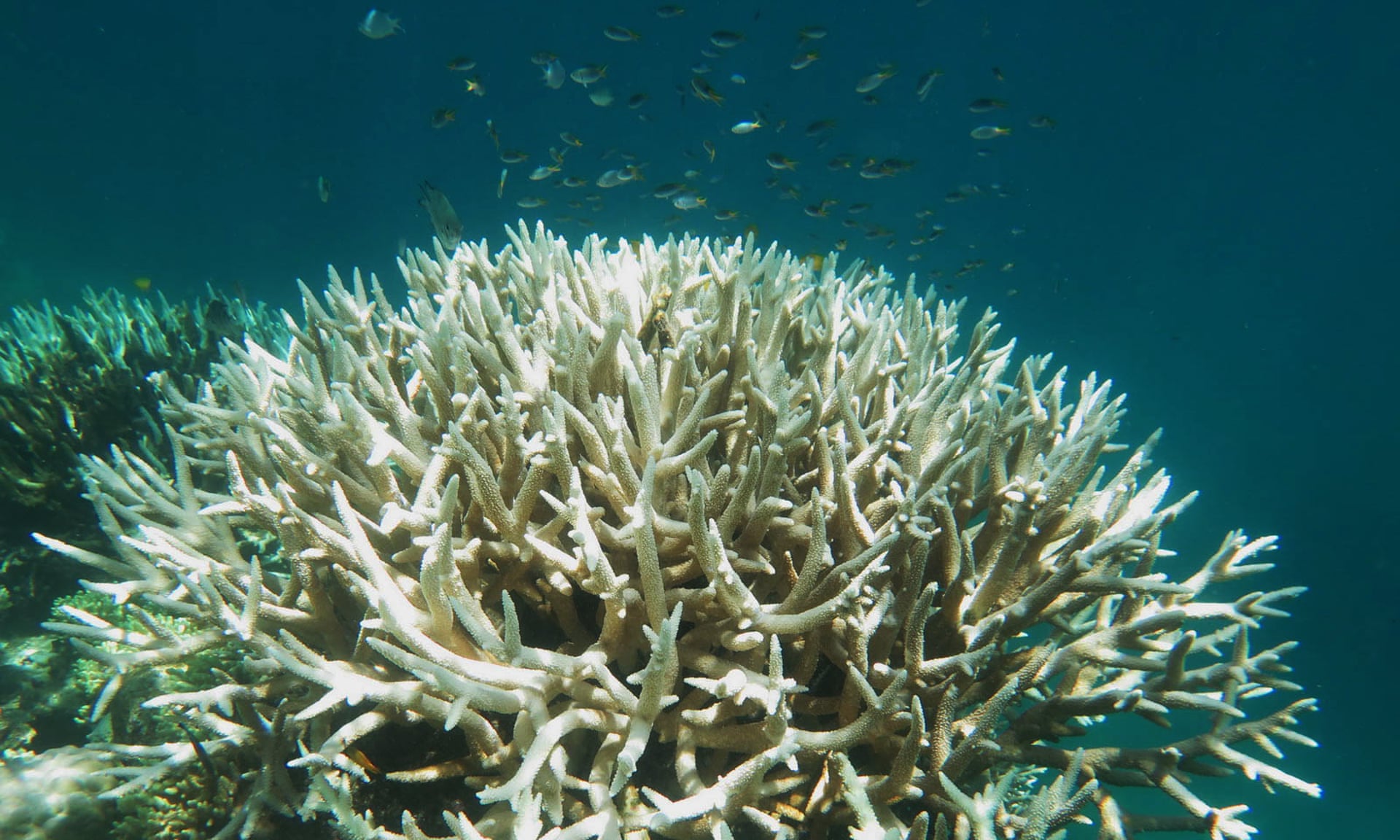Aerial view of parts of the Great Barrier Reef that has experienced coral bleaching, March 2017.
Video courtesy ARC Centre of Excellence for Coral Reef Studies.
Video courtesy ARC Centre of Excellence for Coral Reef Studies.
‘Last year was bad enough, this is a disaster,’ says one expert as Australia Research Council finds fresh damage across 8,000km
Back-to-back severe bleaching events have affected two-thirds of Australia’s Great Barrier Reef, new aerial surveys have found.
The findings have caused alarm among scientists, who say the proximity of the 2016 and 2017 bleaching events is unprecedented for the reef, and will give damaged coral little chance to recover.
Scientists with the Australian Research Council’s Centre of Excellence for Coral Reef Studies last week completed aerial surveys of the world’s largest living structure, scoring bleaching at 800 individual coral reefs across 8,000km.
The results show the two consecutive mass bleaching events have affected a 1,500km stretch, leaving only the reef’s southern third unscathed.
Where last year’s bleaching was concentrated in the reef’s northern third, the 2017 event spread further south, and was most intense in the middle section of the Great Barrier Reef.
This year’s mass bleaching, second in severity only to 2016, has occurred even in the absence of an El Niño event.
Mass bleaching – a phenomenon caused by global warming-induced rises to sea surface temperatures – has occurred on the reef four times in recorded history.
Prof Terry Hughes, who led the surveys, said the length of time coral needed to recover – about 10 years for fast-growing types – raised serious concerns about the increasing frequency of mass bleaching events.
“The significance of bleaching this year is that it’s back to back, so there’s been zero time for recovery,” Hughes told the Guardian.
“It’s too early yet to tell what the full death toll will be from this year’s bleaching, but clearly it will extend 500km south of last year’s bleaching.”
Aerial surveys of the world’s largest living structure, scoring
bleaching at 800 individual coral reefs across 8,000km.
Photograph: Ed
Roberts/ARC
Hughes has warned Australia now faces a closing window to save the reef by taking decisive action on climate change.
The 2017 bleaching is likely to be compounded by other stresses on the reef, including the destructive crown-of-thorns starfish and poor water quality.
The category-four tropical cyclone Debbie came too late and too far south for its cooling effect to alleviate bleaching.
“It added to the woes of the bleaching. It came too late to stop the bleaching, and it came to the wrong place,” he said.
The University of Technology Sydney’s lead reef researcher, marine biologist David Suggett, said that to properly recover, affected reefs needed to be connected to those left untouched by bleaching.
He said Hughes’ survey results showed such connectivity was in jeopardy.
“It’s that connection ultimately that will drive the rate and extent of recovery,” Suggett said. “So if bleaching events are moving around the [Great Barrier Reef] system on an annual basis, it does really undermine any potential resilience through connectivity between neighbouring reefs.”
Some reef scientists are now becoming despondent.
Water quality expert, Jon Brodie, told the Guardian the reef was now in a “terminal stage”.
Brodie has devoted much of his life to improving water quality on the reef, one of a suite of measures used to stop bleaching.
ARC conducted an aerial and underwater survey of the reef which
concluded that two-thirds of it has been hit by mass coral bleaching for
second time in 12 months.
Photograph: Ed Roberts/ARC
“We’ve given up. It’s been my life managing water quality, we’ve failed,” Brodie said.
“Even though we’ve spent a lot of money, we’ve had no success.”
Brodie used strong language to describe the threats to the reef in 2017.
He said the compounding effect of back-to-back bleaching, Cyclone Debbie, and run-off from nearby catchments should not be understated.
“Last year was bad enough, this year is a disaster year,” Brodie said.
“The federal government is doing nothing really, and the current programs, the water quality management is having very limited success. It’s unsuccessful.”
Bleached coral at Mission Beach Reefs.
Photograph: Bette Willis/ARC Centre of Excellence for Coral Reef Studies
Others remain optimistic, out of necessity.
Jon Day was a director of the Great Barrier Reef Marine Park Authority for 16 years until retiring in 2014.
Day, whose expertise lies in protected area planning and management, said the federal government’s approach to protecting the reef was sorely lacking.
He said it was taking too relaxed an approach to fishing, run-off and pollution from farming, and the dumping of maintenance dredge spoil.
The government was far short of the $8.2bn investment needed to meet water quality targets, he said, and Australia was on track to fail its short-term 2018 water quality targets, let alone achieve more ambitious long-term goals.
“You’ve got to be optimistic, I think we have to be,” Day said.
“But every moment we waste, and every dollar we waste, isn’t helping the issue. We’ve been denying it for so long, and now we’re starting to accept it. But we’re spending insufficient amounts addressing the problem.”
The latest surveys spell more bad news for the Great Barrier Reef. Following a record high water surface temperature and mass bleaching event in 2016, the Australian icon may be on track for a similar event this year.
Aerial and underwater footage from 2016 and 2017, shown in this video, shows the extent of the bleaching and die-off, which has already impacted large portions of the reef.
The Queensland tourism industry raised questions about the reliability of the survey, saying scientists had previously made exaggerated claims about mortality rates and bleaching.
“There is no doubt that we have had a significant bleaching event off Cairns this time around,” said Col McKenzie, of the Association of Marine Park Tourism Operators.
“The far north probably did a little bit better, Port Douglas to Townsille has seen some significant bleaching,” he said.
“Fortunately we haven’t seen much mortality at this time, and fortunately the temperatures have fallen.”
McKenzie said more money needed to be invested in water quality measures, and criticised what he saw as a piecemeal and uncoordinated approach to water quality projects up and down the coast.
Underwater video shows where bleaching has damaged the Great Barrier Reef
Links :
- GeoGarage blog :Vast reef discovered behind Great Barrier Reef / Watch terrifying video of coral convulsing as seas heat up / A computer just changed the Coral research game / Great Barrier Reef: 93% of reefs hit by coral bleaching / Australia admits barrier reef conditions are poor / Extreme heat bleaches coral, and threat is seen / Great Barrier Reef has lost half its corals since 1985, new ...
- National Geographic : Warming Bleaches Two-Thirds of Great Barrier Reef
- The Guardian : How did the Great Barrier Reef reach 'terminal stage'? – video explainer / Australia's politicians have betrayed the Great Barrier Reef and only the people can save it
- Climate Central : Scientists Just Confirmed the Great Barrier Reef Bleached
- Washington Post : ‘An enormous loss’: 900 miles of the Great Barrier Reef have bleached severely since 2016






It’s amazing in support of me to truly have a web site that is valuable meant for my knowledge.
ReplyDelete